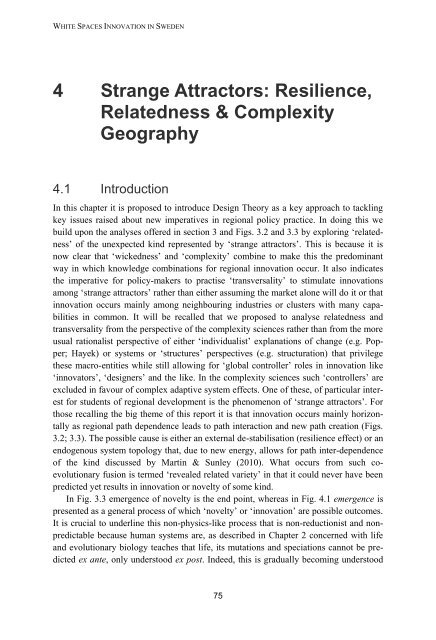White Spaces Innovation in Sweden - Innovation policy for ... - Vinnova
White Spaces Innovation in Sweden - Innovation policy for ... - Vinnova
White Spaces Innovation in Sweden - Innovation policy for ... - Vinnova
You also want an ePaper? Increase the reach of your titles
YUMPU automatically turns print PDFs into web optimized ePapers that Google loves.
WHITE SPACES INNOVATION IN SWEDEN4 Strange Attractors: Resilience,Relatedness & ComplexityGeography4.1 IntroductionIn this chapter it is proposed to <strong>in</strong>troduce Design Theory as a key approach to tackl<strong>in</strong>gkey issues raised about new imperatives <strong>in</strong> regional <strong>policy</strong> practice. In do<strong>in</strong>g this webuild upon the analyses offered <strong>in</strong> section 3 and Figs. 3.2 and 3.3 by explor<strong>in</strong>g „relatedness‟of the unexpected k<strong>in</strong>d represented by „strange attractors‟. This is because it isnow clear that „wickedness‟ and „complexity‟ comb<strong>in</strong>e to make this the predom<strong>in</strong>antway <strong>in</strong> which knowledge comb<strong>in</strong>ations <strong>for</strong> regional <strong>in</strong>novation occur. It also <strong>in</strong>dicatesthe imperative <strong>for</strong> <strong>policy</strong>-makers to practise „transversality‟ to stimulate <strong>in</strong>novationsamong „strange attractors‟ rather than either assum<strong>in</strong>g the market alone will do it or that<strong>in</strong>novation occurs ma<strong>in</strong>ly among neighbour<strong>in</strong>g <strong>in</strong>dustries or clusters with many capabilities<strong>in</strong> common. It will be recalled that we proposed to analyse relatedness andtransversality from the perspective of the complexity sciences rather than from the moreusual rationalist perspective of either „<strong>in</strong>dividualist‟ explanations of change (e.g. Popper;Hayek) or systems or „structures‟ perspectives (e.g. structuration) that privilegethese macro-entities while still allow<strong>in</strong>g <strong>for</strong> „global controller‟ roles <strong>in</strong> <strong>in</strong>novation like„<strong>in</strong>novators‟, „designers‟ and the like. In the complexity sciences such „controllers‟ areexcluded <strong>in</strong> favour of complex adaptive system effects. One of these, of particular <strong>in</strong>terest<strong>for</strong> students of regional development is the phenomenon of „strange attractors‟. Forthose recall<strong>in</strong>g the big theme of this report it is that <strong>in</strong>novation occurs ma<strong>in</strong>ly horizontallyas regional path dependence leads to path <strong>in</strong>teraction and new path creation (Figs.3.2; 3.3). The possible cause is either an external de-stabilisation (resilience effect) or anendogenous system topology that, due to new energy, allows <strong>for</strong> path <strong>in</strong>ter-dependenceof the k<strong>in</strong>d discussed by Mart<strong>in</strong> & Sunley (2010). What occurs from such coevolutionaryfusion is termed „revealed related variety‟ <strong>in</strong> that it could never have beenpredicted yet results <strong>in</strong> <strong>in</strong>novation or novelty of some k<strong>in</strong>d.In Fig. 3.3 emergence of novelty is the end po<strong>in</strong>t, whereas <strong>in</strong> Fig. 4.1 emergence ispresented as a general process of which „novelty‟ or „<strong>in</strong>novation‟ are possible outcomes.It is crucial to underl<strong>in</strong>e this non-physics-like process that is non-reductionist and nonpredictablebecause human systems are, as described <strong>in</strong> Chapter 2 concerned with lifeand evolutionary biology teaches that life, its mutations and speciations cannot be predictedex ante, only understood ex post. Indeed, this is gradually becom<strong>in</strong>g understood75
















